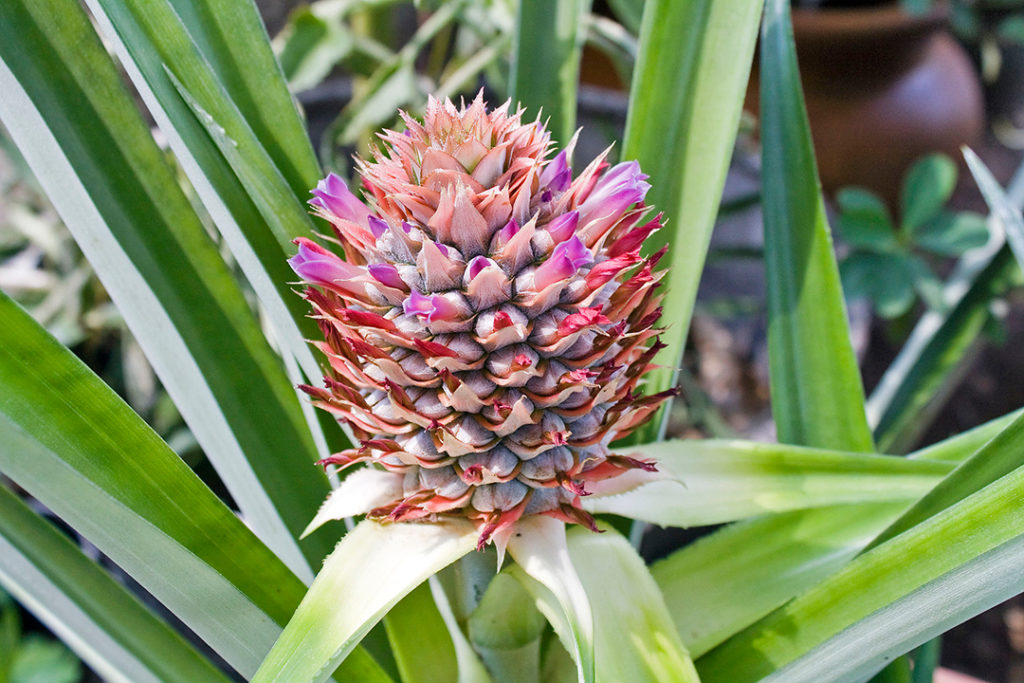
Guinea
Pineapple
Ananas comosus

General Description / Cultural Significance
Pineapple, Ananas comosus, smells sweet as it ripens and is important to the country Guinea-Conakry. It has been an important commercial crop to them in the past, and is having a resurgence recently. Pineapple is a succulent perennial with long spiked leaves that produces edible fruit that is very popularly eaten raw, cooked, or juiced. The majority of pineapple is sold canned, and sometimes the inside is candied or a sugary syrup is produced from the juice. Pineapple is a source of bromelain, which is known to help with digestion and constipation. Pineapple juice can also effectively ease sore throats. It is acidic, and a source of vitamins A and C. Pineapple bran is the residue after juicing and is used as livestock feed. It is unsafe to consume sour or over-ripe fruit.
In 1958, Guinea severed its ties with France and remained a major exporter of pineapples into the 1960s. As of 2019, the government was trying its best to encourage young people not to leave the country and to farm pineapples. By the year 2000 it was no longer a major exporter due to both international and social tensions. Farming pineapples today is not as costly as other crops, and once new farmers learn the necessary agricultural practices, they can be very successful at it.
Climate Change/Conservation Status
Climate change is bringing increasing temperatures to the country, which is affecting water availability for agriculture during the country’s warmest months according to the IFPRI West Africa Agriculture and Climate Change. Both increased temperatures and lower rainfall have negative effects on water availability. West Africa’s rich forest and resources are also at risk due to recurrent droughts, rising sea levels and deforestation with large consequences for economic development and food security.
As most food crops are rainwater fed, emphasis is being placed on irrigation systems to protect economic resilience and thus on agricultural production. There is lack of access in the country to affordable electrical power and a poor water delivery system are the prime factors that keep Guinea from being a site for major external investment in horticultural ventures. Water and energy intensive activities like large-scale farming prove difficult for Guinea.
Recently there have been plans to monitor and determine how to respond to climate change disasters more effectively in the country. And the people in the country are optimistic about the revitalization of the pineapple industry.
Alternate Names
Sources
Climate Links, n.d. Guinea. U.S. Aid of International Development. [website]
Conde, Sidafa, et al., 2012. West African Agriculture and Climate Change: A Comprehensive Analysis – Guinea. International Food Policy Research Institute. [website]
Egbejule, E., 2019. How the Humble Pineapple is Curbing Guinean Immigration to Europe. Ozy. [website]
Fern, K., n.d. Ananas comosus. Useful Tropical Plants Database. [website]
Kiogi, B., 2017. Guinea eyes export of 100 tonnes of pineapple by January 2018,” Africa Business Communities. [website]
Link Climates, 2006. Fresh Pineapples in the Republic of Guinea: An Investment Analysis. U.S. Agency of International Development. [website]
Studies in Science, n.d. Medical uses of Ananas comosus. Studies in Science. [website]
Permanent Mission of the Republic of Guinea to the United Nations. This statement can be found on the World Sensorium original website.
Plant for a Future, n.d. Ananas comosus. Plant for a Future. [website]
Purdue University, 1997. Ananas comosus. Purdue University Center for New Crops and Plant Products. [website]
The World Bank, 2019. Guinea and UNDP launch new adaptation project to prepare for climate change impacts. UNDRR. [website]

